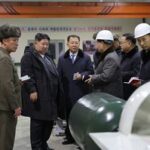
North Korea’s state-run media, KCNA, reported on the 29th that Chairman Kim Jong Un directed the test launch of a submarine-launched strategic cruise missile. ⓒKCNA
North Korea claimed to have repeatedly launched cruise missiles from submarines just three days after the missile provocation. It seems to be focusing on strengthening naval power by continuously testing new weapons according to the plan established at the year-end settlement meeting last year.
The state-run KCNA reported on the 29th that Chairman Kim Jong Un directed the test launch of the newly developed submarine-launched strategic cruise missile “Bulhwasal-3-31” with the secretaries of the Central Committee of the Party, naval commanders, and other leading officers in the previous morning. It reported that the missiles “Flew in the East Sea for 7421 seconds and 7445 seconds, hitting an island target”.
Our military previously announced that it had detected a cruise missile launch from the sea near Sinpo in North Korea around 8 am the previous day, saying, “The US and South Korean intelligence agencies are conducting a detailed analysis”.
Given that North Korea had announced on the 24th that it had conducted the first test launch of the “Bulhwasal-3-31” strategic cruise missile and released related photos, this serves to claim that it has succeeded in diversifying the launch platform by using a submarine just four days after the first test launch.
 North Korea’s state-run media, KCNA, reported on the 29th that Chairman Kim Jong Un directed the test launch of a submarine-launched strategic cruise missile. ⓒKCNA
North Korea’s state-run media, KCNA, reported on the 29th that Chairman Kim Jong Un directed the test launch of a submarine-launched strategic cruise missile. ⓒKCNAMilitary: “Possibility of Exaggeration Related to Changing the Launch Platform in a Short Period”
Our military showed a cautious response, suggesting that North Korea’s announcement might be exaggerated.
Lee Sung-jun, Chief of the Public Affairs Office of the Joint Chiefs of Staff, said at a regular briefing at the Ministry of National Defense on the same day, “We are focusing on the possibility that the flight times claimed by North Korea are exaggerated,” and “Additional matters are being analyzed by the US and South Korean intelligence agencies.”
Lee also said, “Even the identical missile requires considerable technical supplementation and development depending on where it is launched,” and “The fact that the launch platform was changed in such a short period is likely to be related to the possibility of exaggeration”.

Repeated Tests of Nuclear Weapons’
North Korea’s provocations have continued every week without fail since the new year. The opening act was the 370 rounds of naval gunfire poured into the ‘West Sea Buffer Zone’ from the 5th to the 7th. North Korea declared the abolition of the South-North military agreement on November 9th and 19th last year and carried out provocations targeting the buffer zone specified in the military agreement as a follow-up measure.
Although Kim Yo-jong, who oversees North Korea’s foreign policy, even used the trick of claiming that ‘the South Korean military mistook the sound of explosives for gunfire’, there was no reverberation.
North Korea also carried out a provocation with the new medium-range ballistic missile which applied solid fuel on the 14th. Five days later, it claimed to have tested a new underwater nuclear weapon system (Haeil-5-23). Then, on the 24th and 28th, it repeatedly launched the cruise missile Bulhwasal-3-31.
The ‘naval strengthening measures’ emphasized at the year-end meeting of the Workers’ Party last year seem to be in full swing since January. Experts have predicted that North Korea, which has been focusing on securing ‘second-strike capability’, is likely to focus on the development of underwater weapons systems this year. The second-strike capability refers to the ability to retaliate with nuclear weapons even if a country suffers significant damage from an opposing country’s first strike (nuclear attack).
North Korea has “Suggested the execution of tasks that fell short of reaching the five major goals of national defense development in a short period by undergoing the second naval industrial revolution in the shipbuilding industry sector and enhancing the underwater and surface power of the Navy, as its central task” through the conclusion of the party meeting.
The ‘Five Major Goals of National Defense Development’ were established at the occasion of the 8th Party Congress in 2021, and the main goals related to the navy were △solid engine submarine-launched ballistic missile (SLBM) △nuclear submarine △underwater launch nuclear strategic weapon, etc.
The Haeil-5-23 and Bulhwasal-3-31, which North Korea has claimed to have tested over the past few weeks, are interpreted as military actions to achieve the related goals.

In the same context, Chairman Kim Jong Un also inspected the nuclear submarine construction project the day before.
The agency reported that Chairman Kim “Concretely understood the nuclear submarine construction project,” and “Discussed issues related to the construction of nuclear-powered submarines and other new ships, revealed the tasks and national strategies that the relevant sectors should perform, and gave important conclusions on their execution methods.”
Chairman Kim said, “The current situation and prospective threats require us to step up our efforts to defend our maritime sovereignty,” and “The nuclear armament of the navy is an urgent historical task and a core requirement for the construction of national nuclear strategic forces”.
In particular, the agency explained that he set ‘commanding tasks’ aiming at the realization of naval nuclear armament and the multi-dimensional expansion of the operation region of nuclear deterrence.
Since North Korea has announced that it will diversify the launch origin by introducing various maritime nuclear weapons, provocations such as submarine-launched ballistic missiles (SLBM) are expected to continue at the sea.
















Most Commented